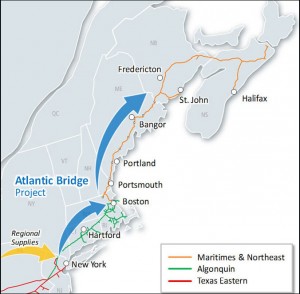In the last month, Spectra Energy Partners LP has moved forward in the federal processes for two different projects on the Algonquin Gas Transmission line.
Spectra intends to modify its natural gas pipeline in four states, including New York and Connecticut. It plans to replace sections of the pipeline with larger diameter pipes, replace meter stations used to monitor the gas, add compressors to help transport gas along the route and make changes to various meter stations.
On March 3, roughly one year after applying for a certificate to proceed in construction, the Algonquin Incremental Market Project was given the go-ahead by the Federal Energy Regulatory Commission for the $971.6 million project.
The 66-page document approved about 37.4 miles of pipeline modification. The biggest chunk will replace 20.1 miles of 26-inch-diameter pipeline with 42-inch-diameter pipeline in Putnam, Rockland and Westchester counties and Fairfield County in Connecticut.
In addition, Spectra will add compressor units at six stations in New York, Connecticut and Rhode Island, including modifying station piping at the Stony Point Compressor Station in Rockland County and at the Southeast Compressor Station in Putnam County. Connecticut will also add new meter stations and replace one in New London County.
A few weeks earlier, on Feb. 20, FERC approved a pre-filing review of Spectra”™s Atlantic Bridge Project, which looks to make similar improvements and expansions on the AIM Project, but along different sections of the Algonquin transmission pipeline.
This project is aimed at modifying the pipeline along roughly 36.2 miles total, constructing one new compressor station, adding two compressor units and making improvements to some existing meter stations.
As the Atlantic Bridge Project gets closer to filing its certificate application, which Spectra hopes to do by the end of the year, there will be multiple open houses in March to provide information and gather input from the community.
FERC in its approval of the AIM Project rejected all concerns raised by environmental and residential groups who feared that its construction could prove hazardous.
One major environmental issue concerned the potential for earthquakes in the Ramapo Fault near where the pipeline would cross the Hudson River near the Indian Point Energy Center. According to FERC, “the recorded magnitude of earthquakes in the project area is low and the ground vibration will not pose a problem for a modern welded-steel pipeline. Based on the low seismic risk and occurrence assigned to the project area, we agree with the conclusions in the final EIS (environmental impact statement) and find the risk of damage to pipeline facilities by earthquakes to be low.”
In addition, the Nuclear Regulatory Commission “concluded that a breach and explosion of the proposed 42-inch-diameter natural gas pipeline would not adversely impact the safe operation of the Indian Point facility. Therefore, the final EIS concludes that the project will not result in increased safety impacts at the Indian Point facility.”
At the nearby Buchanan-Verplanck Elementary School, residents and parents of schoolchildren were concerned of the pipeline”™s location near the school.
“The project”™s right-of-way and construction workspace will be about 450 feet from the school facility at the closest point,” according to the FERC document. Citing the utility”™s plans to avoid blasting and instead use open-cut construction near the school, FERC stated the impacts to the school would be “sufficiently minimized.”
U.S. Rep. Nita M. Lowey, D-Harrison, the ranking member on the House Appropriations Committee, said she was disappointed with the decision.
“This decision was made without independent risk analyses, consideration of existing energy sources and transportation routes and a comprehensive review of the project”™s environmental impact on the lower Hudson Valley. We must prioritize the health and safety of our communities and environment,” she said in a statement.
Staff writer Bob Rozycki contributed to this report.




















Comments 1